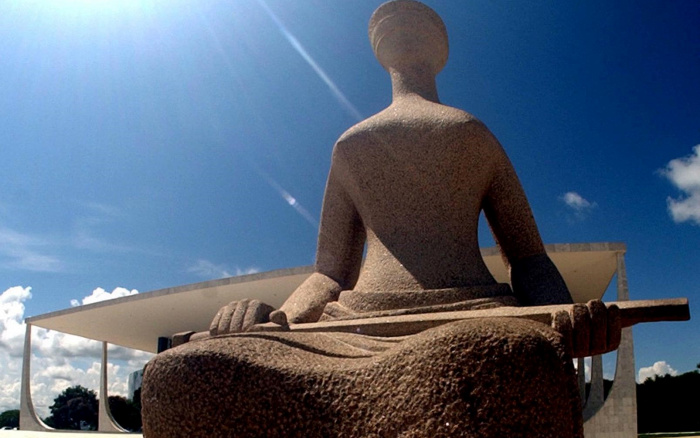Você está na versão anterior do website do ISA
Atenção
Essa é a versão antiga do site do ISA que ficou no ar até março de 2022. As informações institucionais aqui contidas podem estar desatualizadas. Acesse https://www.socioambiental.org para a versão atual.
Brazilian Supreme Court decision reinforces the right of traditional communities to land
terça-feira, 24 de Outubro de 2017 
Esta notícia está associada ao Programa:
The interpretation that the federal government cannot legitimize the possession of land by third parties in traditional community areas is an important step in the defense of land rights for these peoples
On October 18, the justices of the Brazilian Supreme Court (STF) decided that the government could not legitimize the areas of third parties on the land of quilombola, extractivist and riverside communities or other traditional communities. This determination is an important step in defense of the land rights of these populations in general and could potentially influence other cases in the country’s highest court.
A decision was expected on the Direct Unconstitutionality Action (ADI, in Portuguese) 3.239 lodged against Decree 4.887/2003, which regulates the ownership of quilombos – areas inhabited by the communities of descendants of runaway slaves, known as quilombolas. An analysis was also expected for ADI 3646, lodged by the state government of Santa Catarina, which question decrees creating national parks in the state (read more). Supreme Court Justice Dias Toffoli, who was supposed to be the first to vote in the two cases, however, was not in attendance due to illness. For this reason, the agenda of the court was inverted and the justices started by appreciating ADI 4.269. There is no date scheduled for a resumption of the other cases.
In ADI 4.269, the Attorney General of the Republic (PGR, in Portuguese), plaintiff in the suit, asserted that the wording of Law 11.952/2009, which established the Legal Land Program, opened loopholes that allowed the federal government to legitimize areas for third parties in traditional community areas – unlike that established for indigenous lands. The rapporteur for the case, Justice Edson Fachin, and all other justices concurred – with the exception of Marco Aurélio. Marco Aurélio believed that an interpretation on the subject by the Supreme Court was unnecessary.
In his vote, Fachin explained that the Brazilian Constitution provides special protection for lands of communities “with traditional ways of life and for the remaining quilombola communities.” According to him, however, the law analyzed in the case “was deficient or weak in the conferred protection.”
He argues that Convention 169 of the International Labor Organization (ILO), ratified by Brazil, also guarantees the right to land of all traditional populations, including quilombolas, and obligates the Brazilian state to guarantee this right.
Fachin pointed out that the possession of lands by traditional communities is always collective and cannot be legitimized using a law concerning individual ownership. “Both quilombolas and indigenous communities fall under the category of traditional communities, since their essential trait is the preservation of a culture that is different from the majority, maintaining a relationship with the land that is more than just possession or ownership. It is a relationship of identity,” he affirmed.
In the verdict, some justices recalled that, in its initial version, Provisional Measure 458/2009, which gave rise to Law 11.952, explicitly protected the quilombola lands and those of other traditional communities. While working its way through Congress, however, the wording was changed to allow these areas to be legitimized “in accordance with specific norms.” Luiz Fux remarked that Congress should not have made this change without a firm grounding because it affects the fundamental rights of traditional communities.
Protection of the forest
Some of the justices reinforced the need to preserve the forest and the lands of traditional communities as a way of protecting biodiversity and fighting climate change. Luís Roberto Barroso and Celso de Melo, for example, criticized the high rates of deforestation in the Amazon.
“In the areas where delimitation of traditional and indigenous lands has been conducted, the impact on environmental protection has been extremely positive. Protecting indigenous reserves and protecting the areas of quilombolas and traditional communities is good for the preservation of the Amazon and the environment,” said Barroso. He stated that the development model based on deforestation in the Amazon did not improve the quality of life of those who lived there and defended the creation of incentives for economic alternatives to agriculture in the region. “It’s high time Brazil viewed preservation of the Amazon forest as an asset, and not as a liability, as it is frequently treated,” he emphasized.
“The Amazon forest is an extremely positive asset whose integrity should and must be preserved, which will also enable the rational use of its natural resources,” affirmed Celso de Melo. “The Amazon has a importance that goes far beyond its borders. It is fundamental in the balance of world climate and directly influences rainfall patterns not only in Brazil, but throughout Latin America,” he concluded.
At the end of the trial, Chief Justice Cármen Lúcia, announced that the agenda for the day, on socio-environmental rights, was prepared so that the court could provide responses on the topic to society. “The agenda was thematic precisely due to the importance that the Supreme Court gives to the question of the environment while, especially and by extension, to the people who inhabit these areas, especially indigenous, quilombola and traditional communities,” she noted.
Oswaldo Braga de Souza
ISA
Imagens:



